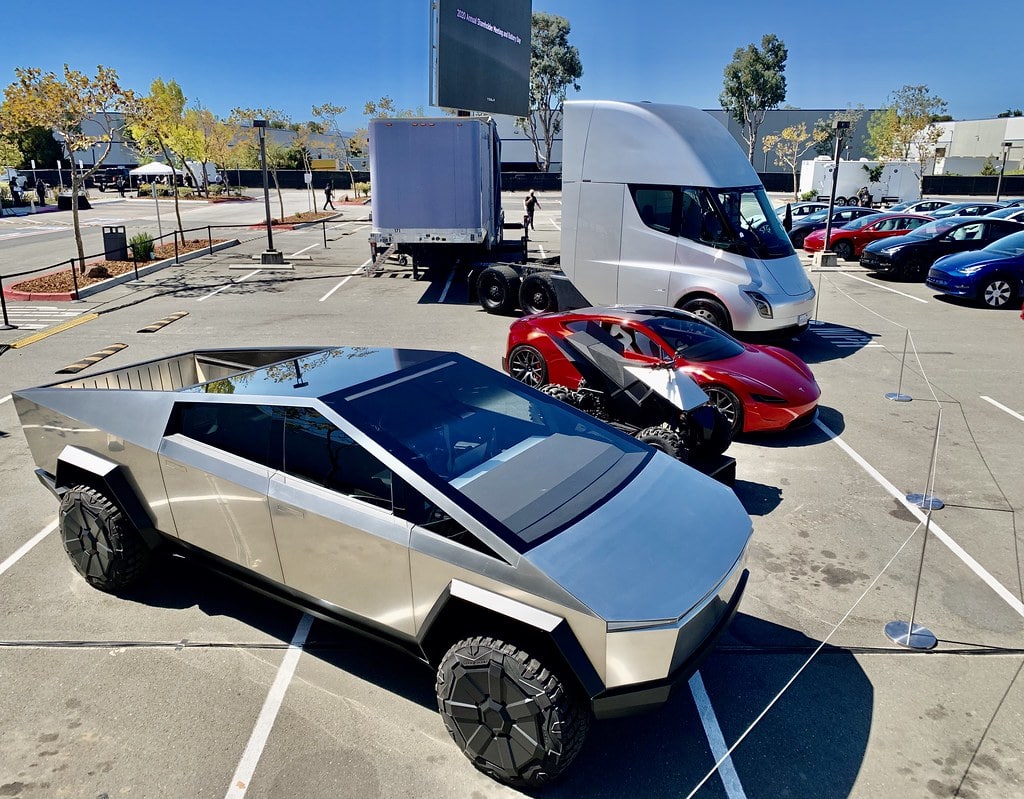
Photo by Dale Cruse licensed under CC BY 2.0. Rechargd.com is reader supported. We may collect a share of sales or other compensation from the links on this page. As an Amazon Associate, we earn from qualifying purchases.
You’ve heard the news that the Cyber Truck is bulletproof. But are you sure it’s true? Unsure of the findings of the demonstrations done on Cyber Truck bulletproof windscreens? Heard about the unique Cyber Truck paneling, but not sure what makes it different?
No, Cyber Trucks are not bullet proof but they do have bullet proof characteristics. This is due to the use of patented multi-layered glass for the windscreen and the use of 3mm thick cold-rolled stainless steel for the car’s panels. Cyber Trucks will deflect bullets in some cases, but not have been designed to meet bullet proof certification.
Metal panels
As to whether the Cyber Truck is truly bulletproof depends on which bullets you fire at it. The panels of the Cyber Truck are fabricated from hardened 3mm Ultra-Hard 30X stainless steel which has been cold-rolled. This is the same metal as the external shell of the SpaceX spacecraft, but is not of the same thickness.
The panels on the exterior of SpaceX craft are thicker. However, this would make Cyber Truck doors too heavy. However, even at 3mm, this material does give the Cyber Truck an amount of bulletproof capacity.
It is said that the Cyber Truck panels will easily withstand bullet fire from a normal 9mm handgun and some (emphasis on the “some”) high-powered rifles. However, the Cyber Truck does not come with an official Armour Rating with respect to its metal panels.
Armor ratings indicate that a 3mm-thick sheet of this type of stainless steel can deflect a 9mm round. However, the Cyber Truck has not been through testing of the requirements for certification, including multiple impacts from specific ranges and angles.
According to ballistics experts, stainless steel is not usually a material used for building armor-proof vehicles. Such vehicles are usually built with air-hardened steel which is then heat-treated. For applications needing to save weight, synthetic laminate fiber materials are commonly used which are up to seven times lighter than steel whilst providing the same level of armor proofing.
The Cyber Truck has not been designed to meet the armor proofing requirements needed for certification. That said, a bullet shot from a standard 9mm handgun is not likely to get past the metal panels.
Windscreen
The Cyber Truck windscreen is made from Tesla’s proprietary glass system. This is essentially laminated glass and is the same sort of material used in banks to protect bank workers. Windscreens of a typical vehicle are already quite difficult to break through bullet fire.
Tesla has taken this a step further with its own “multi-layered glass stack”. This is comprised of an inner-facing glass layer that has been strengthened chemically to give higher strength when flexed. This inner layer of glass is 0.5 to 1.0 mm in thickness and has an adhesive interlayer.
This helps to attach the inner layer to the outer-facing layer which has properties for absorbing energy. The outer-facing layer is made from borosilicate and contains materials such as “ lime and high-density glass”. The outer layer is 2-5 mm in thickness. The inner and outer layers are joined together via energy absorbent adhesive.
The bulletproof capacity of the Tesla Cyber Truck was tested at the vehicle’s launch and was posted online. The windscreen actually cracked following a hit from a sledgehammer and then impact from a series of metal balls. However, it is reported that the initial sledgehammer hit weakened the glass and caused it to be broken by the metal balls.
Other Durability Features
The Cyber Truck may not be “officially” bulletproof, but it is without a doubt very tough. The stainless steel alloy panels are corrosion resistant, and any would-be vandal is going to have a hard time marking the truck’s panels with a set of keys. The hardness and durability of the steel panels are major factors behind the truck’s unique look.
The steel is so hard that it would break a normal vehicle panel stamping press during manufacture causing designers to opt for the flat-panel and angular look of the truck. This fact also helps to keep production costs down.
Without the need for panel stamping and hemming, the only panel manufacturing process involved in the Cyber Truck paneling is laser cutting and welding together the panels. It is the first vehicle of its kind to be constructed in this way.
User testing has shown that a sharp knife can scratch the metal used in Cyber Truck panels. The tests also showed that the truck panels are resistant to denting from a hammer, but that striking with a hammer will create some surface abrasion.
The use of a pickaxe was found to create both dents and surface abrasion. It is also worth noting that the nature of the steel used in Cyber Trucks makes repairs a little tricky. The steel is so hard that any dents successfully made are difficult to buff out as can be done with a normal vehicle panel.
However, if you successfully escape from a pickaxe attack in a Cybertruck, the buffing out of dents is probably likely to be of secondary concern.
